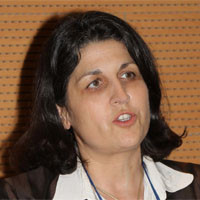Conférence de la Professeure Anna Maria Papini (Florence)
514 343-7339
Site Web
5155, chemin de la rampe
Montréal, QC Canada
H3T 2B2
514 343-6111
Site Web | Itinéraire et carte
Consulté 6578 fois

Titre : A 'Chemical Reverse Approach' to Modulate Peptide Secondary Structures
Inducing Specific and High Affinity Biological Recognition.
Cette conférence sera prononcée par la professeure Anna Maria Papini du Laboratoire français-italien de chimie des peptides et protéine et de synthèse organique sélective et chimie bioorganique (PeptLab-SOSCO), affilié à l'Université de Florence et à l'Université de Cergy Pontoise. Cette dernière sera à Montréal à titre d'examinatrice externe d'une soutenance de thèse en chimie. Elle sera prononcée en anglais.
Résumé : Peptides are interesting tools to be used as model systems when they are able to reproduce biologically relevant small protein structures. However peptides, especially short ones (constrain inside a peptide sequence in order to lock a given conformation, i.e., β-turn and α-helix, possibly reproducing the bioactive conformation. In this context, we defined 'Chemical Reverse Approach' the strategy followed to stabilise peptide conformations inducing specific and high affinity biological recognition. In the last years we performed as a proof-of-concept a systematic work demonstrating that 1,4-disubstituted [1,2,3]triazolyl moiety (bioisosteric to the peptide bond) introduced as a replacement of i-to-i+4 side chain-to-side chain bridging lactam in peptides derived from parathyroid hormone-related protein (PTHrP), was able to reproduce the bioactive α-helical structure. Thus, we applied the [1,2,3]triazolyl-bridging strategy to stabilize a β-turn conformation in MTII. In particular we replaced the lactam bridge with a i-to-i+5 side chain-to-side chain cyclization via CuI-catalyzed azido-to-alkyne 1,3-dipolar cycloaddition (CuAAC) generating 1,4- disubstituted [1,2,3]triazolyl-containing ring structures. The clicked MTII analogs presenting different permutations of bridges with different methylene numbers and a triazolyl moiety were synthesized by a combination of solid phase assembly of the peptide and in solution CuAAC. The biological activity (EC50) towards the principal murine melanocortin receptors of several linear and cyclic MTII peptide analogs compared to the NMR conformational studies lead to an interesting correlation. Such 'Chemical Reverse Approach' was amazingly useful to develop efficient diagnostic/prognostic assays for autoimmune diseases. In fact, β-turn peptide structures and multivalent structures (MEPs) optimally exposing multiple copies of possible aberrant post-translationally modified minimal epitopes (mimicking bacterial and/or viral infections, xenobiotics, etc.) were able to increase recognition affinity, making possible to detect and fishing out specific autoantibodies present in sera of patients affected by neurodegenerative/neurodevelopment immune mediated diseases, i.e. multiple sclerosis and autistic pervasive disorders (Rett Syndrome). Interestingly, the autoantibodies purified by peptide-based immunoaffinity columns were able to select possible candidate protein autoantigens involved in neurodegeneration. Therefore, specific peptide-based apheresis could be a challenging non invasive immunotherapeutic strategy for children neurodegenerative diseases.
Information supplémentaire au sujet d'Anna Maria Papini
Interdepartmental Laboratory of Peptide and Protein Chemistry and Biology (PetLab)



